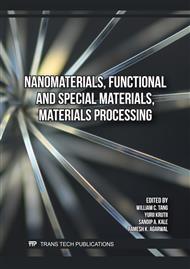[1]
O. Goryk, S. Koval'chuk, O. Brykun, T Lapenko, The stability period of attacking shots in the process of shot blasting of metal surfaces, AIP Conference Proceedings. 2840(1) (2023).
DOI: 10.1063/5.0167634
Google Scholar
[2]
A. Skoczylas, K. Zaleski, Study on the Surface Layer Properties and Fatigue Life of a Workpiece Machined by Centrifugal Shot Peening and Burnishing, Materials. 15 (2022).
DOI: 10.3390/ma15196677
Google Scholar
[3]
O. Goryk, S. Koval'chuk, O. Brykun, S. Aksonov, Assessment of quality criteria of shot blasting cleaning of the inner surfaces of chemically resistant containers, Lecture Notes in Mechanical Engineering. (2023) 98–107.
DOI: 10.1007/978-3-031-18487-1_10
Google Scholar
[4]
P. Mayer, A. Dmitruk, N. Leja, E. Pakiet, Pull-off strength of fibre-reinforced composite polymer coatings on steel substrate, Journal of Adhesion. 98(3) (2022) 286–304.
DOI: 10.1080/00218464.2020.1831478
Google Scholar
[5]
Y. Y. Avcu, E. Iakovakis, M. Guney, E. Çalım, A. Özkılınç, E. Abakay, E. Avcu, Surface and tribological properties of powder metallurgical cp-ti titanium alloy modified by shot peening, Coatings. 13(1) (2023).
DOI: 10.3390/coatings13010089
Google Scholar
[6]
N. Wang, J. Zhu, B. Liu, X. Zhang, J. Zhang, S. Tu, Influence of ultrasonic surface rolling process and shot peening on fretting fatigue performance of ti-6Al-4V, Chinese Journal of Mechanical Engineering. 34 (2021).
DOI: 10.1186/s10033-021-00611-1
Google Scholar
[7]
Z.-C. Huang, Z.-J. Zhou, Y.-Q. Jiang, Effect of shot peening on static and fatigue properties of self–Piercing riveting joints. J. Mater. Res. Technol. 18 (2022) 1070–1080.
DOI: 10.1016/j.jmrt.2022.03.031
Google Scholar
[8]
O. Haghighi, K. Amini, F. Gharavi, Effect of shot peening operation on the microstructure and wear behavior of AZ31 magnesium alloy, Protection of Metals and Physical Chemistry of Surfaces. 56(1) (2020) 164–168.
DOI: 10.1134/s2070205120010098
Google Scholar
[9]
S. Zhang, B. Zou, Y. Liu, Y. Wang, C. Huang, Edge passivation and quality of carbide cutting inserts treated by wet micro-abrasive blasting. Int J Adv Manuf Technol. 96 (2018) 2307–2318.
DOI: 10.1007/s00170-018-1705-7
Google Scholar
[10]
Y. Zhang, F. Lai, S. Qu, V. Ji, H. Liu, X. Li, Effect of shot peening on residual stress distribution and tribological behaviors of 17Cr2Ni2MoVNb steel, Surface and Coatings Technology. 386, (2020).
DOI: 10.1016/j.surfcoat.2020.125497
Google Scholar
[11]
M. Walczak, M. Szala, Effect of shot peening on the surface properties, corrosion and wear performance of 17-4PH steel produced by DMLS additive manufacturing, Archives of Civil and Mechanical Engineering. 21(4) (2021) 1–20.
DOI: 10.1007/s43452-021-00306-3
Google Scholar
[12]
J. Liu, C. Ye, Y. Dong, Recent development of thermally assisted surface hardening techniques: A review, Advances in Industrial and Manufacturing Engineering. 2 (2021).
DOI: 10.1016/j.aime.2020.100006
Google Scholar
[13]
A. Moradi, A. Heidari, K. Amini, F. Aghadavoudi, R. Abedinzadeh, Taguchi analysis of shot peening parameters for surface hardness, wear resistance, roughness, and residual stress in ti-6Al-4V alloy, Kovove Materialy. 60(4) (2022) 267–279.
DOI: 10.31577/km.2022.4.267
Google Scholar
[14]
A. B. Edward, P. Stephan Heyns, S. Kok, A numerical investigation of a single-shot in a DEM-FEM approach to shot peening simulation, Metals. 9(11) (2019).
DOI: 10.3390/met9111183
Google Scholar
[15]
H. Yuan, Z. You, Y. Zhuo, X. Ye, L. Zhu, W. Yang, Numerical and Experimental Study on Reasonable Coverage of Shot Peening on ZGMn13 High Manganese Steel. Front. Mater. 9:897718 (2022).
DOI: 10.3389/fmats.2022.897718
Google Scholar
[16]
A. Goryk, S. Koval'chuk, O. Brykun, R. Chernyak, Viscoelastic Resistance of the Surface Layer of Steel Products to Shock Attack of a Spherical Pellet, Key Engineering Materials. 864 (2020) 217–227.
DOI: 10.4028/www.scientific.net/kem.864.217
Google Scholar
[17]
T. Wang, J. B. Wang, X. J. Zhang, C. Liu, A study on energy conversion behavior of single-shot elastic-plastic impact during shot peen forming, International Journal of Impact Engineering. 176 (2023).
DOI: 10.1016/j.ijimpeng.2023.104566
Google Scholar
[18]
J. Shao, S. Ding, Gю Wu, Z. Zhang, C. Li, Studies on residual stress and surface topography after pneumatic shot peening using discrete element method-finite element method coupled model. Proceedings of the Institution of Mechanical Engineers, Part L. 238(8) (2024) 1585-1604.
DOI: 10.1177/14644207241230751
Google Scholar
[19]
J. Shortiss, D. Tanner, Residual stress prediction in shot blasted cobalt–chromium biomedical cast components, Materials Science and Technology (United Kingdom). 38(12) (2022) 853–865.
DOI: 10.1080/02670836.2022.2065764
Google Scholar
[20]
L. Meng, Y. Shan, A.M. Khan, M. Jamil, N. He, Holistic 3D simulations and experimental investigation of surface quality and residual stresses in shot peening. Int J Adv Manuf Technol. 121 (2022) 1027–1047.
DOI: 10.1007/s00170-022-09273-2
Google Scholar
[21]
J. Zhao, W. Zhou, J. Tang, T. Jiang, H. Liu, Analytical and experimental study on the surface generation mechanism in shot peening, Archives of Civil and Mechanical Engineering. 22(3) (2022).
DOI: 10.1007/s43452-022-00431-7
Google Scholar
[22]
Z. Qin, B. Li, H. Zhang, T. Y. A. Wilfried, T. Gao, H. Xue, Effects of shot peening with different coverage on surface integrity and fatigue crack growth properties of 7B50-T7751 aluminum alloy. Engineering Failure Analysis. 133 (2021).
DOI: 10.1016/j.engfailanal.2021.106010
Google Scholar
[23]
P. S. Reddy, P. R. Kumar, D. V. S. S. S. V. Prasad, B. S. Rani, C. H. L. N. Gupta, A. D. Das, R. Subbiah, Effect of parameters and surface analysis on eglin steel by shot blasting method, Materials Today: Proceedings. 72 (2023) 2833–2836.
DOI: 10.1016/j.matpr.2022.07.248
Google Scholar
[24]
S.Wang, R. Hao, H. Liu, X. Wang, Q. Yang, Fracture behavior of the hot rolled Strip's surface scale layer from different impacts angles, Key Engineering Materials. 905 (2022)67-72.
DOI: 10.4028/www.scientific.net/kem.905.67
Google Scholar


